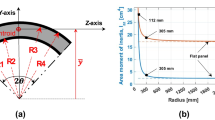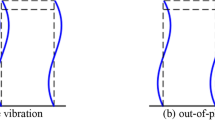Abstract
Uniformity in seismic response of apparently irregular bridges has been an intensive topic of research. EuroCode proposes a force-based criterion that indicates whether such bridges under seismic ground motion are considered uniform or not. In this research, several case study three-span bridges with unequal pier heights and different pier-to-deck connection configurations are designed as per EC8 requirements for irregular bridges, then investigated for (a) seismic response uniformity up to collapse limit state, (b) intrinsic overstrength, and (c) material usage efficiency under inelastic static pushover as well as incremental dynamic analysis using a bin of seven real earthquakes. Design optimization targeting regular response is performed on each bridge scheme based on an enhanced curvature-based uniformity criterion, and the results are compared to the initial design complying with EuroCode requirements. Among the main conclusions of the current research is that irregular bridges under investigation complying with EuroCode uniformity index do not necessarily behave in a uniform manner under seismic loading. Response uniformity has been improved drastically by altering the steel reinforcement ratios of either the short or the long pier and/or by changing the types of pier-to-deck connection. Associated changes in the inherent overstrength of each scheme as well as the usage efficiency of piers reinforcement are also monitored and compared to the initial design. The current investigation hence emphasizes that it is the designer’s role to accentuate and delineate the main aspects of the design requirement of irregular bridges: either heading towards better uniformity in response and/or improved built-in overstrength, or targeting a more economically efficient design in terms of piers reinforcement ratio but with reduced, yet satisfactory, uniformity. All these aspects could however be more-or-less mutually accomplished but with certain limitations.















Similar content being viewed by others
References
Abbasi M, Zakeri B, Amiri G (2015) Probabilistic seismic assessment of multiframe concrete box-girder bridges with unequal-height piers. ASCE J Perform Constr Facil. doi:10.1061/(ASCE)CF.1943-5509.0000753,04015016
Caltrans (SDC) (2013) Seismic design criteria, Version 1.7, April 2013
Charney FA (2008) Unintended consequences of modeling damping in structures. ASCE J Struct Eng 134(4)
Chen W-F, Duan L (2003) Bridge engineering seismic design. CRC Press LLC, Boca Raton
EN 1991–2 EC1 (2003) Actions on structures. Part 2: traffic loads on bridges. Comité Européen de Normalisation, Brussels
EN 1992-1-1 EC2 (2004) Design of concrete structures. Part 1-1: general rules and rules for buildings. Comité Européen de Normalisation, Brussels
EN 1998–1 EC8-1 (2005) Design of structures for earthquake resistance. Part 1: general rules, seismic actions and rules for buildings. Comité Européen de Normalisation, Brussels
EN 1998–2 EC8-2 (2005) Design of structures for earthquake resistance, part 2: bridges. Comité Européen de Normalisation, Brussels
Farag MMN, Mehanny SSF, Bakhoum MM (2015) Establishing Optimal Gap Size for Precast Beam Bridges with a Buffer-Gap-Elastomeric Bearings System. Earthq Struct 9(1):195–219
Guirguis JEB, Mehanny SSF (2013) Evaluating codes criteria for regular seismic behavior of continuous concrete box girder bridges with unequal height piers. ASCE J Bridge Eng 18(6):486–498. doi:10.1061/(ASCE)BE.1943-5592.0000383
Ibarra LF, Krawinkler H (2005) Global collapse of frame structures under seismic excitations. Blume Center Report No. 152, School of Civil and Environmental Engineering, Stanford University, CA
Ishac MG (2016) Effects of unequal height piers and pier to deck connections on the uniformity of seismic behavior and inherent strength of apparently irregular bridges. M.Sc., Thesis, Faculty of Engineering, Cairo University
Ishac MG, Mehanny SSF (2015) How to achieve regular seismic behavior of irregular bridges with unequal height piers? In: Papadrakakis M, Papadopoulos V, Plevris V (eds) Proceedings of the 5th ECCOMAS thematic conference on computational methods in structural dynamics and earthquake engineering, Crete Island, Greece, 25–27 May 2015
Karsan ID, Jirsa JO (1969) Behavior of concrete under compressive loading. Proc ASCE J Struct Div 95(ST12):2543–2563
Konstantinidis D, Kelly JM, Makris N (2009) Experimental investigation on the seismic response of bridge bearings. In: 3rd international conference on advances in experimental structural engineering, San Francisco, 15–16 Oct, 2009
Medina R (2002) Seismic demands for non-deteriorating frame structures and their dependence on ground motions. Ph.D. Thesis, Dept. of Civil and Environmental Engineering, Stanford University, CA
Mohammadi-Tamanani M, Gian Y, Ayoub A (2014) Design of bridges with unequal pier heights. Struct Congr 2014:677–686. doi:10.1061/9780784413357.061
OpenSees 2.0.0 [Computer software]. Berkeley, CA, Pacific Earthquake Engineering Research Center, University of California
Paulay T, Priestley MJN (1992) Seismic design of reinforced concrete and masonry buildings. Wiley, New York
Reza SM (2012) Seismic performance of multi-span RC bridge with irregular column heights. Master of Applied Science Thesis, The University of British Columbia, Canada
SCDOT (2008) Seismic design specifications for highway bridges. Ver. 2.0, SC, USA, July 2008
Tehrani P (2012) Seismic analysis and behavior of continuous reinforced concrete bridges. Ph.D. Thesis, McGill University, Montreal, Quebec, Canada
Tehrani P, Mitchell D (2013) Effects of column stiffness irregularity on the seismic response of bridges in the longitudinal direction. Can J Civ Eng 40(8):815–825. doi:10.1139/cjce-2012-0091
Yilmaz T (2008) Seismic response of multi-span highway bridges with two-column reinforcement concrete bents including foundation and column flexibility. MSc Thesis, Middle East Technical Univ., Turkey
Author information
Authors and Affiliations
Corresponding author
Rights and permissions
About this article
Cite this article
Ishac, M.G., Mehanny, S.S.F. Do mixed pier-to-deck connections alleviate irregularity of seismic response of bridges with unequal height piers?. Bull Earthquake Eng 15, 97–121 (2017). https://doi.org/10.1007/s10518-016-9958-8
Received:
Accepted:
Published:
Issue Date:
DOI: https://doi.org/10.1007/s10518-016-9958-8




